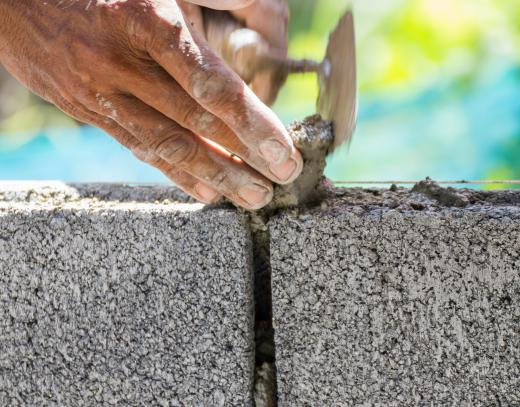Hydraulic lime is a type of lime, or calcium carbonate, which is used to make mortar and plaster products. The lime is heated, then mixed with an aggregate material like sand or stone. Once this mixture is blended with water to form mortar, it can be used in many types of masonry construction projects. The mortar can be placed between bricks or blocks to bind them together, or may even be applied to the surface of the masonry to create a plaster or stucco-like application.
A specialized form of limestone is used to make hydraulic lime. The limestone is mixed with clay then fired in a kiln to high temperatures. This process removes much of the moisture from the lime and also produces mineral by-products known as silicates. The remaining limestone and silicates are combined to form hydraulic lime.

To understand how hydraulic lime works, it is important to first understand how traditional hydrated lime works. When hydrated lime is mixed with water to form mortar, it has a consistency similar to peanut butter. As the mortar reacts with the air, it absorbs carbon dioxide, causing it to harden or cure. Hydraulic lime mortar, or the other hand, begins to harden when it is exposed to water. Over time, it will also absorb carbon dioxide from the air to experience a second phase of hardening or curing. Due to these differing reactions, hydraulic and hydrated lime are very different products and are not interchangeable.

Hydraulic lime offers a number of benefits over traditional lime mortar blends. The most important is its ability to cure and harden when wet, which means it can be used in many applications where other mortar products would fail. It also has low elasticity, resulting in fewer cracks due to expansion and contraction. Hydraulic lime is also very porous, allowing excess moisture to escape rather than collecting inside the wall structure. This makes it very popular for historic preservation applications, where traditional hydrated lime would crack or crumble over time due to trapped moisture.

This product is available in a number of different varieties, which are chosen based on the application. Natural hydraulic lime Type 2 (NHL-2) is designed for interior applications and some exterior uses where the mortar will be protected from moisture. NHL-3.5 is suitable for most exterior applications, while NHL-5 is designed for the toughest outdoor applications, such as floor slabs, underground work, and chimneys.
